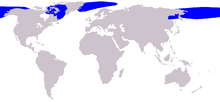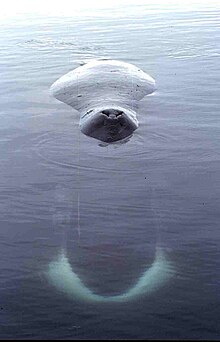Bowhead whale
| Bowhead whale | ||||||||||||
|---|---|---|---|---|---|---|---|---|---|---|---|---|

Bowhead whale |
||||||||||||
| Systematics | ||||||||||||
|
||||||||||||
| Scientific name of the genus | ||||||||||||
| Balaena | ||||||||||||
| Linnaeus , 1758 | ||||||||||||
| Scientific name of the species | ||||||||||||
| Balaena mysticetus | ||||||||||||
| Linnaeus, 1758 |
The bowhead whale ( Balaena mysticetus ) is a species of right whale in arctic seas that is up to 18 meters long and can live for over 200 years.
distribution and habitat
The bowhead whale only lives in arctic waters. The distribution areas of the five remaining populations today are the Davis Strait ( Baffin Bay ) off Labrador , the Bering Sea west of Alaska , the Hudson Bay (Foxe Basin), the Barents Sea (near Spitsbergen ) and the North Siberian waters ( Sea of Okhotsk ).
features

The bowhead whale has a layer of fat up to 70 cm thick that protects it from the freezing cold. The head is very large in relation to the body, almost a third of the total length is taken up by the head, and enables ice layers up to 30 cm thick to break through. The mouth can be up to five meters long, four meters high and two and a half meters wide. The tongue alone can weigh almost 900 kg. The whale has two blow holes from which it can blow two fountains over four meters into the air.
The body of the bowhead whale is dark blue to black in color. Only on the lower jaw is there a white spot with irregularly arranged black dots. There are often white or gray lines on the abdomen. The bowhead whale has no fin (dorsal fin). The fluke (tail fin) can reach a maximum width of eight meters. The pectoral fins are small and paddle-shaped in relation to their size. Adult bulls can grow up to 16 meters long and weigh 50 to 70 tons. Cows can reach a length of up to 18 meters and a weight of up to 100 tons.
The average life expectancy is forty years. On the basis of the old harpoon tips of whales hunted in the body, it was found that bowhead whales can live far more than 100 years. The age of an individual was determined to be 211 years by means of molecular biological studies. This makes them the longest-lived mammals known.
New studies show that bowhead whales have a particularly slow metabolism and are better protected against cancer thanks to their genes .
food
The bowhead whale feeds on plankton such as krill . It has between 325 and 360 beards on each side. While feeding, the whale swims with its mouth constantly open. The small animals get caught in the whiskers, which are stripped off with the tongue and swallowed. This whale's beards are so fine that it can filter even small animals out of the water that other whale species cannot reach.
Reproduction
Mating takes place in spring or early summer. The gestation period is about 13 months, the young are born in April, May or June. Newborn calves are around four meters long. The calf is suckled for half a year. The interval between two births is usually three years. The calves are born with a thick layer of fat.
behavior
During the spring and autumn migrations, bowhead whales form groups of up to 14 animals that swim in a V-shaped formation. Before the time of excessive whaling , these associations are said to have consisted of up to a hundred individual animals.
The bowhead whale stays in the arctic seas all year round. In the arctic winter he can find his way around in the dark using echolocation .
Typical dive times are up to twelve minutes, but bowhead whales can dive for up to an hour. After a dive, the whale spends a minute or two breathing on the surface.
protection

The bowhead whale used to be so common that it was referred to as the Common Whale by British whalers . At the time, it was often described in German as the common whale , although no distinction was made with the northern right whale . Because of the thick layer of fat and the long beard, it was considered very valuable commercially. In the early 18th century, the bowhead whale was in the waters around Spitsbergen almost eradicated. The catch shifted to the waters between Greenland and Canada , where the stocks were depleted during the 18th and 19th centuries. From the mid-19th century that began United States , the whaling in the Bering Sea advance, so hunting was also opened to the Pacific bowhead whales.
In 1931, the bowhead whale was the first wild animal species in the world to be protected by the League of Nations .
The still small stocks are increasing again through protective measures. It is estimated that there are again between 5,000 and 8,000 bowhead whales worldwide, almost all of which lived in the North Pacific. In the North Atlantic, the species was considered completely extinct at the beginning of the 20th century, but here too a small population seems to have survived and is beginning to reproduce again. Due to the now more frequent ice-free Northwest Passage, a few hundred to a thousand specimens have massively increased the Canadian-Greenland population.
The original population at the beginning of the 17th century, i.e. before systematic whaling, is difficult to estimate, but was probably around 50,000 bowhead whales. By the beginning of the 20th century, the population was almost completely wiped out. Bowhead whales have been strictly protected since 1946 and are no longer allowed to be hunted commercially. However, there are still special licenses that allow some Eskimo tribes to hunt a set number of whales in order to ensure their own survival. Between 1990 and 2006 around 50 animals were shot annually. Around 1900, 200 animals were often shot per year. At that time, the usable parts of such an animal were still very valuable, but since the invention of substitutes, hunting has hardly been worthwhile.
Cultural asset whale bone fences
On the West, East and North Frisian Islands , during the whaling era in the 18th century, there was a custom of building fences made of whale bones to delimit the property around the houses. It was by no means intended to create spectacular peculiarities or even run trophy shows, rather this was simply the best available building material on the once completely unforested islands. As a rule, they were bones from the jaws of the bowhead whale, which is most hunted. Two fences on Borkum (both near the old lighthouse), one on Rømø , and small remains on Föhr, Ameland and Schiermonnikoog have been preserved to this day. According to their age, they are in a weathered condition.
literature
- Mark Carwardine: Whales and Dolphins . Delius Klasing, Bielefeld 1996, ISBN 3-7688-0949-8 .
- Ralf Kiefner: whales and dolphins worldwide . Year Top Special Verlag, 2002, ISBN 3-86132-620-5 (guide of the magazine diving , very detailed)
- J. Niethammer, F. Krapp (ed.): Handbook of mammals in Europe . Volume 6: Marine Mammals , Part 1 A: Whales and Dolphins . AULA-Verlag, Wiesbaden 1994, ISBN 3-89104-559-X (very detailed textbook)
- RR Reeves, BS Stewart, PJ Clapham, JA Powell: Sea Mammals of the World. A Complete Guide to Whales, Dolphins, Seals, Sea Lions and Sea Cows . Black, London 2002, ISBN 0-7136-6334-0 (guide with numerous pictures).
- Maurizio Würtz, Nadia Repetto: Underwater world: Dolphins and Whales . White Star Guides, 2003, ISBN 88-8095-943-3 (identification book)
Web links
- Bowhead whale on wale.info
- Balaena mysticetus in the endangered Red List species the IUCN 2006. Posted by: Cetacean Specialist Group, 1996. Retrieved on 6 May, 2006.
Individual evidence
- ↑ Bowhead Whales May Be the World's Oldest Mammals ( Memento of the original from December 9, 2009 in the Internet Archive ) Info: The archive link was automatically inserted and not yet checked. Please check the original and archive link according to the instructions and then remove this notice.
- ↑ Ancient harpoon found in dead whale . Spiegel Online ; Retrieved June 13, 2007
- ↑ Bowhead whale. In: Artenlexikon. WWF (World Wide Fund for Nature), accessed September 17, 2019 .
- ↑ Bowhead whale killed by whalers at the age of 211 . Welt Online , May 25, 2007; accessed on September 19, 2017
- ↑ Bowhead whale killed by whalers at the age of 211 . World online ; Retrieved January 26, 2011.
- ↑ Insights into the Evolution of Longevity from the Bowhead Whale Genome . In: Cell Reports , January 6, 2015; accessed on September 19, 2017
- ↑ What makes the bowhead whale live 200 years . Spiegel Online , January 6, 2015; accessed on September 19, 2017
- ↑ Bowhead whale on wale.info; Retrieved August 7, 2012
- ↑ Video Giants in the ZDFmediathek , accessed on August 7, 2012. (offline)
- ↑ Illustrated natural history of the animal kingdom. First volume: Natural history of the mammals . JJ Weber, Leipzig 1847/48.
- ↑ Lost and Found, No. 186 - More bowhead whales off Greenland . n-tv .de, August 10, 2007
- ↑ Aboriginal Subsistence Whaling catches since 1985 ( Memento of March 9, 2008 in the Internet Archive )
- ↑ https://www.heimatverein-borkum.de/wp-content/uploads/presse/2020/BZ_300120.pdf
- ↑ https://www.roemoe.de/sehenswuerdheiten/walknochen-zaun




